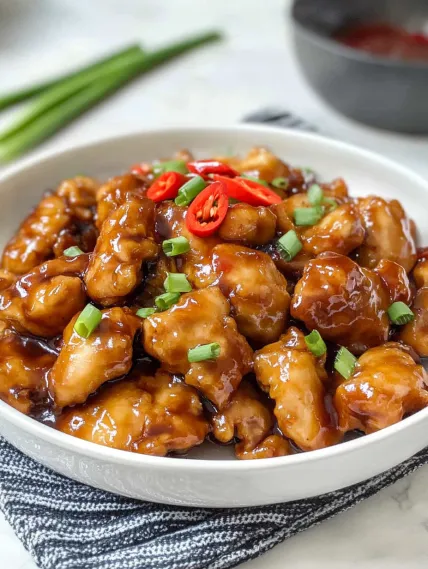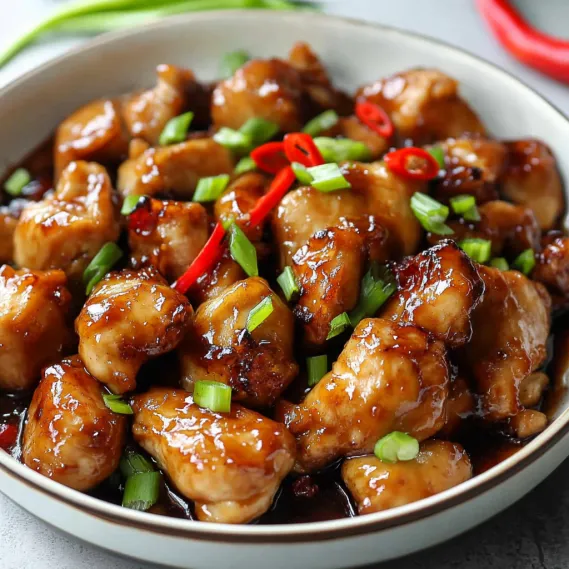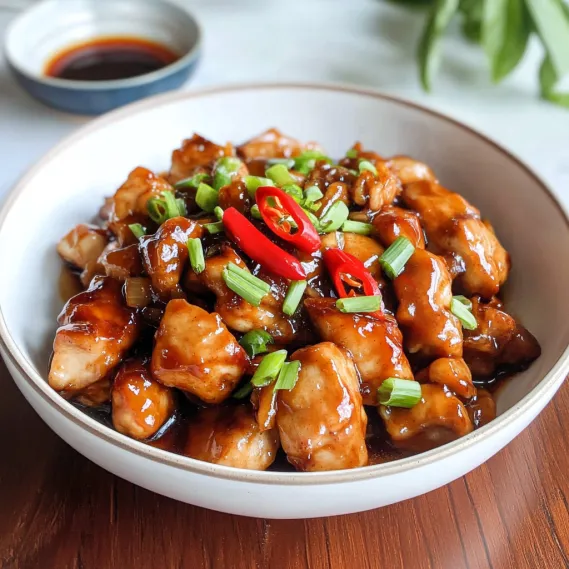 Pin
Pin
Crispy fried chicken tossed in a sticky, sweet, savory sauce - this Mongolian Chicken delivers takeout-quality flavor right from your kitchen. Tender chicken pieces develop a perfect crispy coating before being enveloped in a rich sauce featuring ginger, garlic, and a hint of heat. Ready in just 25 minutes, this irresistible dish will quickly become your go-to for satisfying Chinese food cravings.
I discovered this recipe after moving away from my favorite Chinese restaurant and craving their signature dish. After several attempts to recreate it, this version not only matched but surpassed the original. My family now requests it weekly, and dinner guests always ask for the recipe.
Essential Ingredients and Selection Tips
- Chicken Thighs: Boneless, skinless thighs stay juicier than breast meat. Cut into uniform pieces for even cooking.
- Cornstarch: Creates a crispier coating than flour. Cornstarch makes an acceptable substitute if needed.
- Hoisin Sauce: Provides the signature sweet-savory base. Look for quality brands with fewer additives.
- Fresh Ginger: Essential for authentic flavor. Store in the freezer and grate while frozen for easy use.
- Red Chili: Adjusts the heat level to your preference. Remove seeds for a milder dish.
I've found that leaving a small amount of moisture on the chicken before coating it with cornstarch creates the perfect crust. This simple technique ensures the coating adheres properly and produces that crispy exterior we all love in restaurant versions.
Detailed Cooking Instructions
- Step 1: Prepare the Cornstarch Slurry
- In a small bowl, combine 1 tablespoon cornstarch with ½ cup cold water, stirring until completely dissolved with no lumps remaining. This slurry will thicken the sauce to the perfect consistency, allowing it to cling beautifully to the chicken pieces when added later in the cooking process.
- Step 2: Prepare the Chicken
- Cut 1½ pounds boneless skinless chicken thighs into 1½-inch pieces, keeping them relatively uniform for even cooking. Place the chicken pieces in a large mixing bowl, add ⅓ cup cornstarch, and toss thoroughly until each piece is completely coated with a thin, even layer of cornstarch.
- Step 3: Fry the Chicken
- Heat ¼ cup neutral oil in a large, heavy-bottomed pan over medium-high heat until shimmering but not smoking. Working in small batches to avoid overcrowding, fry the coated chicken pieces for 5-7 minutes, turning occasionally, until golden brown and crispy on all sides with an internal temperature of 165°F.
- Step 4: Prepare the Aromatics
- Pour off excess oil from the pan, leaving about 2 tablespoons. Return the pan to medium heat and add 2 tablespoons minced fresh ginger, 3 cloves minced garlic, and 1 thinly sliced red chili (adjust amount to your spice preference). Stir-fry for about 10 seconds until fragrant but not browned.
- Step 5: Create the Perfect Sauce
- To the aromatic mixture, add 3 tablespoons hoisin sauce, 2 tablespoons soy sauce, 2 tablespoons brown sugar, and 1 teaspoon sesame oil, stirring to combine. Give the cornstarch slurry another quick stir before adding it to the pan, then simmer the sauce for 1-2 minutes until it thickens to a glossy, coat-the-back-of-a-spoon consistency.
- Step 6: Combine Everything
- Stir in the coated chicken pieces, ensuring each piece is thoroughly coated with the sticky, savory sauce. Gently toss to combine, then remove from heat and garnish with extra chopped green onions and toasted sesame seeds before serving immediately.

My first attempt at this recipe taught me the importance of not overcrowding the pan when frying the chicken. When pieces touch, they steam rather than fry, resulting in soggy coating. Now I patiently cook in batches, ensuring each piece has room to develop that perfect crispy exterior that holds up to the sauce.
The Perfect Balance of Flavors
This dish exemplifies the complex flavor harmony found in great Chinese cooking. The sauce balances sweetness from hoisin and brown sugar with savory soy sauce, aromatic ginger, and spicy chili. Fresh garlic adds depth while sesame oil contributes nutty richness. Each component plays an essential role in the final taste profile.

Simple Substitutions for Dietary Needs
Easily adapt this recipe for different dietary requirements. For gluten-free, substitute tamari for soy sauce and find gluten-free hoisin. Make it vegetarian by swapping chicken with extra-firm tofu or seitan. For a lighter version, air-fry the coated chicken instead of pan-frying. The sauce works beautifully with any protein choice.
Serving Suggestions for a Complete Meal
Complete your homemade Chinese feast with complementary sides. Fluffy white rice absorbs the delicious sauce perfectly. Add color with grilled pineapple rings, roasted vegetables, or a fresh cucumber-mango salad. For an authentic restaurant-style presentation, include egg rolls, crab rangoons, or a simple cucumber salad to balance the rich main dish.
Make-Ahead and Storage Tips
Streamline dinner prep by preparing components in advance. Cut and coat chicken up to 8 hours before cooking, storing covered in the refrigerator. The sauce ingredients can be combined and refrigerated separately. Leftovers maintain their flavor for up to 4 days refrigerated. Reheat gently to preserve the chicken's texture.
Tips for Maximum Crispiness
- Achieve crispy, restaurant-quality chicken with a few simple techniques
- Pat chicken completely dry before coating for maximum crispiness
- Fry in small batches to prevent overcrowding and maintain oil temperature
- Use a wire rack instead of paper towels after frying to prevent steam from softening the coating
- Taste the sauce before adding chicken and adjust sweetness or saltiness if needed
I learned the importance of proper chicken preparation after my first attempt resulted in a soggy coating that slipped right off the chicken. Now I even place them uncovered in the refrigerator for an hour before cooking if time allows. This extra step removes surface moisture and results in the crispiest possible skin that holds up beautifully under the sauce.

Chef's Helpful Tips
- Freeze leftover ginger root for easy grating directly into dishes
- Reserve some unused marinade before adding chicken for a perfectly safe basting sauce
- Thread chicken onto skewers with pineapple chunks for easy Hawaiian kebabs
- For a charred exterior, grill on high heat initially then move to medium to finish cooking
- Add a tablespoon of cornstarch to the sauce when reducing for an extra-thick glaze
- Garnish with toasted sesame seeds for added texture and visual appeal
I've been making variations of this pie for over a decade, constantly refining the technique. The most significant improvement came when I started using the broiler to finish the salmon, creating that perfect balance of crisp exterior and tender, juicy interior.
Recipe FAQs
- → Can I use chicken breast instead of thighs?
- Yes, you can substitute chicken breast for thighs in this recipe. Keep in mind that chicken breast is leaner and can dry out more easily. To keep it juicy, cut the breast into slightly larger pieces (about 2 inches) and reduce the cooking time by 1-2 minutes. Watch them carefully to avoid overcooking.
- → How can I make this recipe less sweet?
- To reduce the sweetness, you can cut the brown sugar to 1 tablespoon instead of 2. You can also increase the soy sauce by an additional teaspoon to balance the sweet-savory ratio. Keep in mind that hoisin sauce contains some sweetness too, so the dish will maintain some of its characteristic sweet flavor.
- → Can I make this dish ahead of time?
- While this dish is best served fresh to maintain the chicken's crispiness, you can prepare components ahead of time. You can dice and coat the chicken, then refrigerate it (covered) for up to 4 hours. The sauce ingredients can be mixed and stored separately. When ready to eat, fry the chicken and finish the sauce as directed. Leftovers can be refrigerated for 2-3 days but the chicken won't stay crispy.
- → What can I serve with Mongolian Chicken?
- Mongolian chicken pairs perfectly with steamed white rice or brown rice to soak up the delicious sauce. For a lower-carb option, try cauliflower rice. You can also serve it with simple steamed vegetables like broccoli or bok choy on the side. For a complete takeout-style meal, add vegetable spring rolls or a simple cucumber salad as starters.
- → Is there a way to make this recipe gluten-free?
- Yes, to make this recipe gluten-free, use tamari or gluten-free soy sauce instead of regular soy sauce. You'll also need to find a gluten-free hoisin sauce (available at many health food stores) or make your own from gluten-free ingredients. Make sure your cornstarch is labeled gluten-free, though most cornstarch is naturally gluten-free. With these substitutions, the dish will maintain its flavor while being safe for those with gluten sensitivities.
